International Collaboration in BIM Design: A Case Study of HDR|Rice Daubney and Obayashi Corporation

Technology Category
- Application Infrastructure & Middleware - Event-Driven Application
Applicable Industries
- Cement
- Retail
Applicable Functions
- Product Research & Development
Use Cases
- Construction Management
- Construction Site Monitoring
About The Customer
HDR|Rice Daubney is a creative firm for architecture, planning, and design with experience spanning 38 years across Australia and Asia. As one of Australia’s leading architectural practices, HDR|Rice Daubney produces projects that have a common emphasis on quality, commercial focus, and innovation in design, across all the sectors of the business, Commercial, Retail + Town Centres, Health + Research and Defence. On the other hand, Obayashi Corporation, with its history of around 120 years, is one of the world’s leading construction contractors and Japan’s leading listed companies. Leveraging its core competence, technology, it provides construction services and such construction related services as engineering and urban development.
The Challenge
In 2013, HDR|Rice Daubney of Australia and Obayashi Corporation of Japan participated in the Build Sydney Live event, a 48-hour challenge that required participants from around the world to design a new International Convention Centre for Sydney. The project was part of the specified 19 Hectare area of the Darling Harbour Live project and was run virtually using mobile technology. The event represented a significant challenge due to the strict requirements for design development and presentation materials, as well as the need for effective international collaboration between the two companies. The success of their collaboration depended heavily on their use of Open BIM and Graphisoft Archicad Teamwork through the BIM Server.
The Solution
To overcome the challenge, HDR|Rice Daubney and Obayashi Corporation leveraged more than 10 types of software. In Sydney, HDR|Rice Daubney used SketchUp, Solibri, Rhinoceros, dRofus, while in Tokyo, Obayashi Corporation used FlowDesigner, CADWell Tfas, MIDAS, SS3, Tekla, and NavisWorks. Archicad with Teamwork was used as the authoring tool for the entire communication of all the software. The workflow of Open BIM was described as being “without any issues or problems.” The success of the overseas collaboration was attributed to the fact that “both parties were very experienced with IFC.” The ability to translate between different software packages was a significant benefit in their ability to collaborate in BIM.
Operational Impact

Case Study missing?
Start adding your own!
Register with your work email and create a new case study profile for your business.
Related Case Studies.

Case Study
System 800xA at Indian Cement Plants
Chettinad Cement recognized that further efficiencies could be achieved in its cement manufacturing process. It looked to investing in comprehensive operational and control technologies to manage and derive productivity and energy efficiency gains from the assets on Line 2, their second plant in India.

Case Study
Improving Production Line Efficiency with Ethernet Micro RTU Controller
Moxa was asked to provide a connectivity solution for one of the world's leading cosmetics companies. This multinational corporation, with retail presence in 130 countries, 23 global braches, and over 66,000 employees, sought to improve the efficiency of their production process by migrating from manual monitoring to an automatic productivity monitoring system. The production line was being monitored by ABB Real-TPI, a factory information system that offers data collection and analysis to improve plant efficiency. Due to software limitations, the customer needed an OPC server and a corresponding I/O solution to collect data from additional sensor devices for the Real-TPI system. The goal is to enable the factory information system to more thoroughly collect data from every corner of the production line. This will improve its ability to measure Overall Equipment Effectiveness (OEE) and translate into increased production efficiencies. System Requirements • Instant status updates while still consuming minimal bandwidth to relieve strain on limited factory networks • Interoperable with ABB Real-TPI • Small form factor appropriate for deployment where space is scarce • Remote software management and configuration to simplify operations

Case Study
Digital Retail Security Solutions
Sennco wanted to help its retail customers increase sales and profits by developing an innovative alarm system as opposed to conventional connected alarms that are permanently tethered to display products. These traditional security systems were cumbersome and intrusive to the customer shopping experience. Additionally, they provided no useful data or analytics.

Case Study
How Sirqul’s IoT Platform is Crafting Carrefour’s New In-Store Experiences
Carrefour Taiwan’s goal is to be completely digital by end of 2018. Out-dated manual methods for analysis and assumptions limited Carrefour’s ability to change the customer experience and were void of real-time decision-making capabilities. Rather than relying solely on sales data, assumptions, and disparate systems, Carrefour Taiwan’s CEO led an initiative to find a connected IoT solution that could give the team the ability to make real-time changes and more informed decisions. Prior to implementing, Carrefour struggled to address their conversion rates and did not have the proper insights into the customer decision-making process nor how to make an immediate impact without losing customer confidence.

Case Study
Ensures Cold Milk in Your Supermarket
As of 2014, AK-Centralen has over 1,500 Danish supermarkets equipped, and utilizes 16 operators, and is open 24 hours a day, 365 days a year. AK-Centralen needed the ability to monitor the cooling alarms from around the country, 24 hours a day, 365 days a year. Each and every time the door to a milk cooler or a freezer does not close properly, an alarm goes off on a computer screen in a control building in southwestern Odense. This type of alarm will go off approximately 140,000 times per year, equating to roughly 400 alarms in a 24-hour period. Should an alarm go off, then there is only a limited amount of time to act before dairy products or frozen pizza must be disposed of, and this type of waste can quickly start to cost a supermarket a great deal of money.







